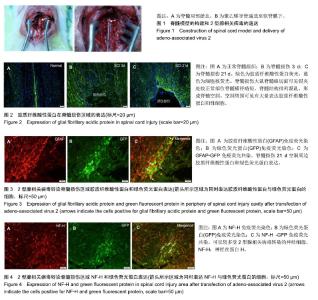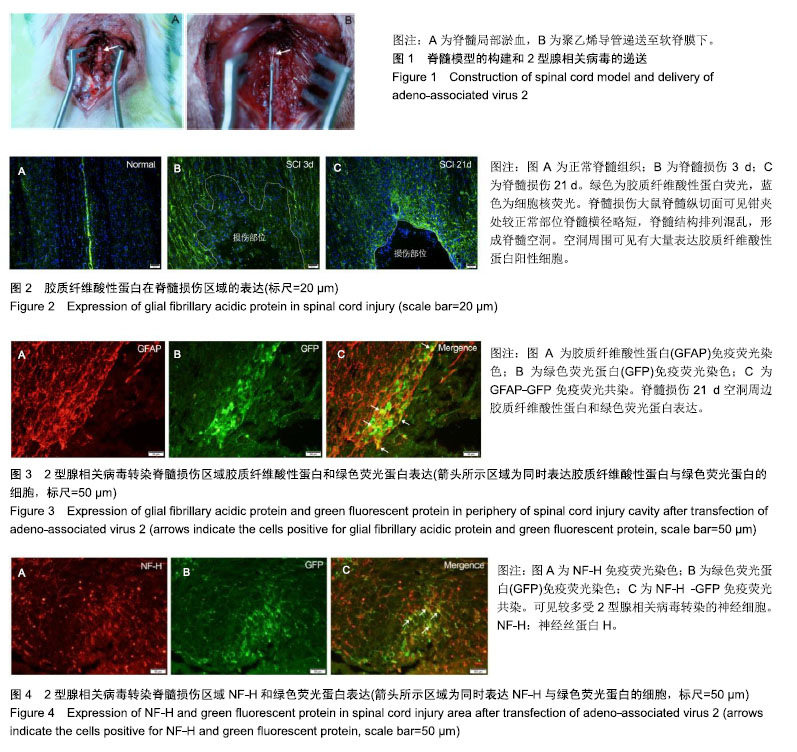| [1]Jendelova P.Therapeutic Strategies for Spinal Cord Injury. Int J Mol Sci. 2018;19(10).pii: E3200.[2]Ahmed A,Patil AA,Agrawal DK.Immunobiology of spinal cord injuries and potential therapeutic approaches.Mol Cell Biochem. 2018;441(1-2):181-189.[3]Dalamagkas K,Tsintou M,Seifalian A,et al. Translational Regenerative Therapies for Chronic Spinal Cord Injury. Int J Mol Sci. 2018;19(6). pii: E1776. [4]Ahuja CS,Nori S,Tetreault L,et al.Traumatic Spinal Cord Injury-Repair and Regeneration. Neurosurgery. 2017;80(3): S9-S22.[5]Huang X,Gu YK,Cheng XY,et al.[Astrocytes as therapeutic targets after spinal cord injury]. Sheng Li Xue Bao.2017;69(6): 794-804.[6]李剑锋,闫金玉,夏润福,等.脊髓损伤胶质瘢痕形成及星形胶质细胞作用的研究与转化意义[J].中国组织工程研究, 2016,20(37): 5609-5616.[7]Okada S,Hara M,Kobayakawa K,et al.Astrocyte reactivity and astrogliosis after spinal cord injury. Neurosci Res. 2018;126:39-43.[8]Sofroniew MV,Vinters HV.Astrocytes: biology and pathology. Acta Neuropathol. 2010;119(1):7-35.[9]Lu X,Xue P,Fu L,et al.HAX1 is associated with neuronal apoptosis and astrocyte proliferation after spinal cord injury. Tissue Cell. 2018;54:1-9.[10]Kameda T,Imamura T,Nakashima K.Epigenetic regulation of neural stem cell differentiation towards spinal cord regeneration. Cell Tissue Res. 2018;371(1):189-199.[11]Chen XQ, Chen C, Hao J, et al. Effect of CLIP3 Upregulation on Astrocyte Proliferation and Subsequent Glial Scar Formation in the Rat Spinal Cord via STAT3 Pathway After Injury. J Mol Neurosci. 2018;64(1):117-128.[12]Ramadan WS,Abdel-Hamid GA, Al-Karim S, et al. Neuroectodermal stem cells: A remyelinating potential in acute compressed spinal cord injury in rat model.J Biosci.2018;43(5): 897-909.[13]巩朝阳,刘开鑫,向高,等.脊髓损伤后胶质瘢痕形成的研究进展[J].中国康复理论与实践,2018,24(6):641-644.[14]Song JL,Zheng W,Chen W,et al.Lentivirus-mediated microRNA-124 gene-modified bone marrow mesenchymal stem cell transplantation promotes the repair of spinal cord injury in rats. Exp Mol Med. 201719;49(5):e332. [15]Yin H,Shen LM,Xu C,et al.Lentivirus-Mediated Overexpression of miR-29a Promotes Axonal Regeneration and Functional Recovery in Experimental Spinal Cord Injury via PI3K/Akt/mTOR Pathway. Neurochem Res. 2018;43(11):2038-2046. [16]Choudhury SR,Hudry E,Maguire CA,et al.Viral vectors for therapy of neurologic diseases. Neuropharmacology.2017; 120:63-80. [17]Saraiva J,Nobre RJ,De Almeida LP.Gene therapy for the CNS using AAVs: The impact of systemic delivery by AAV9. J Control Release. 2016;241:94-109.[18]Gao GP,Vandenberghe LH,Alvira MR, et al. Clades of Adeno-associated viruses are widely disseminated in human tissues. J Virol. 2004;78(12):6381-6388.[19]陈如意,陈素峰,周丹,等.2型腺相关病毒作为基因治疗载体的研究进展[J].生命科学,2013,25(6):595-600.[20]Davidson BL, Stein CS, Heth JA, et al. Recombinant adeno-associated virus type 2, 4, and 5 vectors: transduction of variant cell types and regions in the mammalian central nervous system. Proc Natl Acad Sci U S A.2000;97(7): 3428-3432.[21]Murlidharan G,Samulski RJ,Asokan A.Biology of adeno- associated viral vectors in the central nervous system. Front Mol Neurosci.2014;7:76. [22]Tadokoro T, Miyanohara A, Navarro M,et al.Subpial Adeno-associated Virus 9 (AAV9) Vector Delivery in Adult Mice. J Vis Exp. 2017;(125). doi: 10.3791/55770.[23]Gray SJ,Matagne V,Bachaboina L,et al.Preclinical Differences of Intravascular AAV9 Delivery to Neurons and Glia: A Comparative Study of Adult Mice and Nonhuman Primates. Molecular Therapy.2011;19(6):1058-1069.[24]Samaranch L,Salegio EA,San Sebastian W,et al. Adeno- Associated Virus Serotype 9 Transduction in the Central Nervous System of Nonhuman Primates. Human Gene Therapy.2012;23(4):382-389.[25]Miyake N, Miyake K, Yamamoto M, et al. Global gene transfer into the CNS across the BBB after neonatal systemic delivery of single-stranded AAV vectors. Brain Res. 2011;1389:19-26. [26]Povysheva T,Shmarov M,Logunov D,et al.Post-spinal cord injury astrocyte-mediated functional recovery in rats after intraspinal injection of the recombinant adenoviral vectors Ad5-VEGF and Ad5-ANG. J Neurosurg Spine. 2017;27(1): 105-115.[27]李东卿.经肋间后动脉介入移植骨髓基质干细胞修复脊髓损伤的研究[D].广州:南方医科大学,2012.[28]杞少华,王海峰,熊文平,等.骨髓间充质干细胞尾静脉注射与局部靶点注射对大鼠脊髓损伤修复效果的比较[J].中华实验外科杂志, 2013,30(6):1322.[29]Miyanohara A,Kamizato K,Juhas S,et al.Potent spinal parenchymal AAV9-mediated gene delivery by subpial injection in adult rats and pigs. Mol Ther Methods Clin Dev. 2016;3:16046[30]Xu QH,Chou B,Fitzsimmons B,et al.In Vivo Gene Knockdown in Rat Dorsal Root Ganglia Mediated by Self-Complementary Adeno-Associated Virus Serotype 5 Following Intrathecal Delivery. Plos One.2012;7(3):11.[31]Ceyzeriat K, Abjean L, Carrillo-De Sauvage MA, et al. The complex STATes of astrocyte reactivity: How are they controlled by the JAK-STAT3 pathway?. Neuroscience. 2016; 330:205-218.[32]Ben Haim L,Ceyzeriat K,Carrillo-De Sauvage MA,et al.The JAK/STAT3 Pathway Is a Common Inducer of Astrocyte Reactivity in Alzheimer's and Huntington's Diseases. J Neurosci. 2015;35(6):2817-2829.[33]杨进顺,吕浩然,廖壮文,等.大鼠急性脊髓损伤动物模型的建立及影像学分析[J].广东医学,2011,32(5):559-561.[34]刘小康,徐建广,连小峰,等.大鼠钳夹式急性脊髓损伤模型的制备与评价[J].中国矫形外科杂志,2012,20(14):1318-1322.[35]杨俊松,郝定均,刘团江,等.急性脊髓损伤的临床治疗进展[J].中国脊柱脊髓杂志,2018,28(4):368-373.[36]Sumida Y,Kamei N,Suga N,et al.The endoplasmic reticulum stress transducer old astrocyte specifically induced substance positively regulates glial scar formation in spinal cord injury. Neuroreport.2018; 29(17):1443-1448.[37]Silva NA,Sousa N,Reis RL,et al.From basics to clinical: a comprehensive review on spinal cord injury. Prog Neurobiol. 2014;114:25-57.[38]Nathan FM, Li S.Environmental cues determine the fate of astrocytes after spinal cord injury.Neural Regen Res. 2017; 12(12):1964-1970.[39]Pekny M,Pekna M.Astrocyte reactivity and reactive astrogliosis: costs and benefits. Physiol Rev. 2014;94(4):1077-1098.[40]Pekny M,Wilhelmsson U,Pekna M.The dual role of astrocyte activation and reactive gliosis. Neurosci Lett.2014;565:30-38.[41]Zou YX,Stagi M,Wang XX,et al.Gene-Silencing Screen for Mammalian Axon Regeneration Identifies Inpp5f (Sac2) as an Endogenous Suppressor of Repair after Spinal Cord Injury. J Neurosci. 2015;35(29):10429-10439.[42]Hu JL,Zhang GX,Rodemer W,et al.The role of RhoA in retrograde neuronal death and axon regeneration after spinal cord injury. Neurobiol Dis. 2017;98:25-35. |

